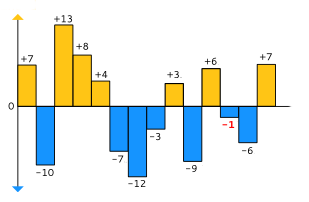The Goal
In this exercise, you have to analyze records of temperature to find the closest to zero.

Rules
Game Input
Line 1: N, the number of temperatures to analyze
Line 2: A string with the N temperatures expressed as integers ranging from -273 to 5526
Solution
When we start reading the temperatures \(t_i\) with the first iteration, we don't have a current minimum \(m\), so that the first element will always update the minimum. From now on the minimum will only be set to the current element \(t_i\) if \(|t_i| < |m|\). When \(|t_i| = |m|\) we need to set the minimum to the absolute value \(|t_i|\). That means we can implement the check like this:
#include <iostream>
#include <sstream>
using namespace std;
int main() {
int N;
cin >> N;
cin.ignore();
string TEMPS;
getline(cin, TEMPS);
istringstream buf(TEMPS);
int t, m = 0;
for (int i = 0; i < N; ++i) {
buf >> t;
if (i == 0 || abs(t) < abs(m)) {
m = t;
} else if (abs(t) == abs(m)) {
m = abs(t);
}
}
cout << m << endl;
return 0;
} This algorithm works fine, but we call the abs function quite often. We can remove the else-if branch by dissecting all cases for \(|t_i| = |m|\):
t > 0
m > 0: keep m
m < 0: take t
m = 0: keep m
t < 0
m > 0: keep m
m < 0: keep m
m = 0: keep m
t = 0
m > 0: keep m
m < 0: keep m
m = 0: keep m That means we can remove the else-if branch and add t == -m && t > 0 or'ed to the first. We can do the same for \(|t| < |m|\):
t > 0
m > 0
t < m
m < 0
t < -m
m = 0
false
t < 0
m > 0
-t < m
m < 0
-t < -m
m = 0
false
t = 0
m > 0
t < m
m < 0
t < -m
m = 0
false
=>
t > 0, m > 0, t < m
t > 0, m < 0, t < -m
t < 0, m > 0,-t < m
t < 0, m < 0,-t < -m
t = 0, m > 0, t < m
t = 0, m < 0, t < -m
=>
t > 0, m > t
t > 0, m < -t
t < 0, m > -t
t < 0, m < t
t = 0, m > t
t = 0, m < t
=>
t >= 0, m > t
t < =0, m < t
t > 0, m < -t
t < 0, m > -t
t > 0, t = -m # from first equation
=>
t >= 0, m > t
t <= 0, m < t
t > 0, m <= -t
t < 0, m > -t Stating the improved algorithm again:
#include <iostream>
#include <sstream>
using namespace std;
int main() {
int N;
cin >> N;
cin.ignore();
string TEMPS;
if (N == 0) {
cout << 0 << endl;
return 0;
}
getline(cin, TEMPS);
istringstream buf(TEMPS);
int t, m;
buf >> m;
for (int i = 1; i < N; ++i) {
buf >> t;
if (t >= 0 && m > t || t <= 0 && m < t || t > 0 && m <= -t || t < 0 && m > -t) {
m = t;
}
}
cout << m << endl;
return 0;
} Well, the original code was much more readable and is thus of more practical value, but it was nice to see how far we can go with the optimization.
All images are copyright to Codingame